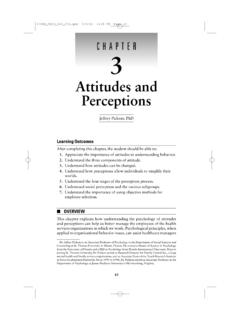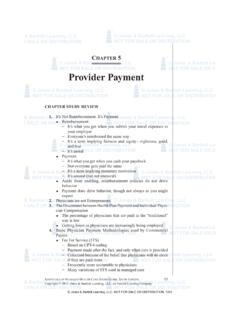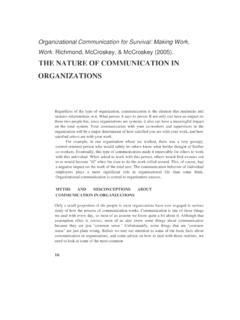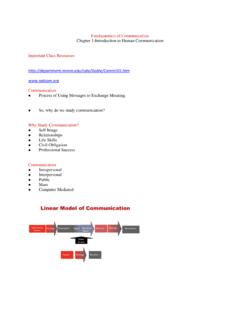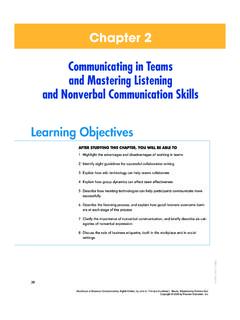Transcription of Workplace Communication - jblearning.com
1 CHAPTER477 WorkplaceCommunicationKristina L. Guo, PhDandYesenia Sanchez, MPHL earning OutcomesAfter completing this chapter, the student should be able to:1. Describe the Communication the importance of feedback in the various verbal and nonverbal methods the common barriers to various methods to overcome Communication L. Guo is an Assistant Professor of Health Services Administration in the Stempel School ofPublic Health at Florida International University in Miami, Florida. Professor Guo graduated fromFlorida International University with a PhD in Public Administration in 1999, and she holds a Mastersin Public Health from the University of Miami. Prior to joining the Florida International University fac-ulty, Dr. Guo accumulated extensive experience in the healthcare field. She was the Assistant Directorof the University of Miami s intellectual property division, where she conducted market and patent re-search and analyses.
2 As the manager of several physician practices, she was responsible for formulat-ing and implementing strategies to increase the organization s viability and growth potential. She teacheshealth services management, organizational behavior, and health policy. Her primary areas of researchare healthcare policy and management, where she has developed a managerial roles and skills assess-ment tool. Her current research focuses on the healthcare needs of Sanchez is a contracting specialist for Neighborhood Health Partnership, a five-star healthmaintenance organization in Florida. Ms. Sanchez holds a Master s in Public Health from FloridaInternational University. She is an adjunct professor for the College of Health & Urban Affairs at FloridaInternational University. She teaches organizational behavior, healthcare policy, and epidemiology. Herprimary areas of research are in healthcare policy and organizational 3/9/05 4:51 PM Page the elements of effective Communication for the various components for effective the flow of intraorganizational the challenges of cross-cultural Communication .
3 The flow of Communication with external stakeholdersand the public sector. OVERVIEWF undamental and vital to all healthcare managerial functions, communi-cation is a means of transmitting information and making oneself under-stood by another or others. Communication is a major challenge formanagers because they are responsible for providing information, whichresults in efficient and effective performance in the creation or exchange of thoughts, ideas, emotions,and understanding between sender(s) and receiver(s). It is essential tobuilding and maintaining relationships in the managers spend most of their time communicating ( ,sending or receiving information), one cannot assume that meaningfulcommunication occurs in all exchanges (Dunn, 2002). Once a memo-randum, letter, fax, or e-mail has been sent, many are inclined to believethat Communication has taken place. However, Communication does notoccur until information and understanding have passed between senderand the intended receiver.
4 To make oneself understood as intended is an important part of com-munication. A receiver may hear a sender but still not understand whatthe sender s message means. Being constantly engaged in encoding anddecoding messages does not ensure that a manager is an expert in com-munication. Understanding is a personal matter between people, and dif-ferent people may interpret messages differently. If the idea received is notthe one intended, Communication has not taken place; the sender hasmerely spoken or written. Communication PROCESSF igure 4-1illustrates the Communication process. It shows that the senderis a person, department, or unit of an organization or system who orig-inates the message. A sender uses words and symbols to put forth infor-mation into a message for the receiver, the individual(s) receiving themessage. Messages are then received and decoded or interpreted by thereceiver. Decoding is affected by the receiver s prior experiences andframes of reference.
5 Accurate decoding of the message by the receiver 3/9/05 4:51 PM Page 78critical to effective Communication . The closer the decoded message getsto the intent of the sender, the more effective the Communication . However,environmental and personal barriers can hamper the communicationprocess. Details on barriers are described in a later section. To ensuremessages are received as intended, feedback is a necessary component ofthe Communication process. The receiver creates feedback to a messageand encodes it before transmitting it back to the sender. The sender re-ceives and decodes the feedback. Feedback is the destination s reactionto a message (Certo, 1992). It is an important element of communica-tion since it allows for information to be shared between the receiver andsender in a two-way Communication . FEEDBACKF eedbackis any information that individuals receive about their behav-ior. Feedback can be information related to the productivity of groupsin an organization, or the performance of a particular individual.
6 For in-stance, a manager requires feedback to determine staff acceptance of hisor her newly set policy whereby staff must phone all patients to confirmtheir appointments 48 hours in advance of the appointments. Throughthe feedback process, senders and receivers may adjust their outputs asrelated to the transmitted information. In the absence of feedback, or inthe case where the Communication process does not allow for sufficientfeedback to develop, or feedback is ignored, a certain amount of feed-back will occur spontaneously and tends to take a negative form. In one-way Communication , a person sends a one-directional messagewithout interaction. When a physician writes out a prescription and givesit to the nurse to hand to the patient, the physician s order is an exampleFeedback79 SenderMessage Create EncodeSenderMessage Receive DecodeBarriers Environment PersonalFeedback Receive DecodeFeedback Create EncodeFigure 4-1 The Communication ProcessSource:McShane, , and Von Glinow, (2003) Organizational behavior: Emerging realities for the Workplace revo-lution(2nd ed.)
7 Boston: McGraw-Hill, p. 3/9/05 4:51 PM Page 79of one-way Communication and does not provide the opportunity forthe patient to ask questions directly. A negative feedback may occur whenthe patient expresses frustration or anger through verbal or nonverbalmessages when the physician does not directly explain the necessity andfunctions of the medication. However, the same patient could expresssatisfaction and appreciation toward the nurse who explains the useful-ness of the medication. In this case, the opportunity for feedback resultsin two-way Communication between the patient and the nurse. Two-waycommunication is more accurate and information-rich when the mes-sage is complex, although one-way Communication is more efficient, asin the case of the physician s written prescription. To be effective, Communication must allow opportunities for feed-back. Feedback can take several forms, each with a different (2002) provides us with three different forms of feedback: de-scriptive, evaluative, and prescriptive.
8 Descriptive feedback. Feedback that identifies or describes how aperson communicates. For instance, Manager A asks Manager B tocomment on her behavior at a staff meeting. B indicates that A wasspecific, clear, and instructive on introducing the staff to the com-puter database for managing patient accounts. B provides a descrip-tive feedback of A s behavior at the staff meeting. Evaluative feedback. Feedback that provides an assessment of theperson who communicates. In the above case, if Manager B evalu-ates Manager A s behavior and concludes that she is instructive andhelpful, and that causes the staff to feel comfortable when going toA for help or asking questions, then B has provided positive evalua-tive feedback of A s interaction with the staff. Prescriptive feedback. Feedback that provides advice about howone should behave or communicate. For example, Manager A asksManager B how she could have made changes to better communi-cate her message to her staff.
9 B suggests for A to be friendlier andmore cooperative by giving the staff specific times that A is avail-able for help with the new computer database. This type of advice isprescriptive feedback. In addition to forms and intent, there are also four levels of can focus on a group or an individual working with specifictasks or procedures. It can also provide information about relationshipswithin the group or individual behavior within a group (Keyton, 2002). Task or procedural feedback. Feedback at this level involves issuesof effectiveness and appropriateness. Specific issues that relate totask feedback include the quantity or quality of a group s instance, are patients satisfied with the new outpatient clinic?Did the group complete the project on time? Procedural 3/9/05 4:51 PM Page 80refers to whether a correct procedure was used appropriately at thetime by the group. Relational feedback.
10 Feedback that provides information about in-terpersonal dynamics within a group. This level of feedback empha-sizes how a group gets along while working together. It is effectivewhen it is combined with the descriptive and prescriptive forms offeedback. Individual feedback. Feedback that focuses on a particular individ-ual in a group. For example, is an individual in the group knowl-edgeable? Does he or she have the skills helpful to this group? Whatattitudes does he or she have toward the group as they work togetherto accomplish their tasks? Is the individual able to plan and organizewithin a schedule that contributes to the group s goal attainment? Group feedback. Feedback that focuses on how well the group is per-forming. Like the questions raised at the individual feedback level,similar questions are asked for the group. Do team members withinthe group have adequate knowledge to complete a task?
